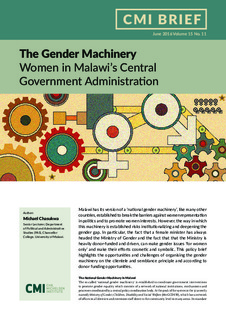| dc.contributor.author | Chasukwa, Michael | |
| dc.date.accessioned | 2018-01-04T08:21:28Z | |
| dc.date.available | 2018-01-04T08:21:28Z | |
| dc.date.issued | 2016-06-01 | |
| dc.identifier | oai:www.cmi.no:5880 | |
| dc.identifier.citation | Bergen: Chr. Michelsen Institute (CMI Brief) 4 p. | |
| dc.identifier.issn | 0809-6732 | |
| dc.identifier.uri | http://hdl.handle.net/11250/2475208 | |
| dc.description.abstract | Malawi has its version of a ‘national gender machinery’, like many other countries, established to break the barriers against women representation in politics and to promote women interests. However, the way in which this machinery is established risks institutionalizing and deepening the gender gap. In particular, the fact that a female minister has always headed the Ministry of Gender and the fact that that the Ministry is heavily donor-funded and driven, can make gender issues ‘for women only’ and make their efforts cosmetic and symbolic. This policy brief highlights the opportunities and challenges of organising the gender machinery on the clientele and semblance principle and according to donor funding opportunities. | |
| dc.language.iso | eng | |
| dc.publisher | Chr. Michelsen Institute | |
| dc.relation | CMI Brief | |
| dc.relation | 11 | |
| dc.relation.ispartof | CMI Brief | |
| dc.relation.ispartofseries | CMI Brief vol. 15 no. 11 | |
| dc.relation.uri | https://www.cmi.no/publications/5880-the-gender-machinery-women-in-malawis-central | |
| dc.subject | Malawi | |
| dc.title | The Gender Machinery Women in Malawi’s Central Government Administration | |
| dc.type | Report | |
